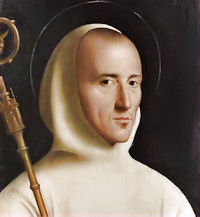Lent: April 1st
Saturday of the Fifth Week of Lent
Other Commemorations: St. Hugh of Grenoble, Bishop (RM)
» Enjoy our Liturgical Seasons series of e-books!
The Liturgy is already inviting us to live in spirit Christ’s Passion and Death. In the Gospel we hear the death sentence passed onto Jesus by the High Priest and the Council.
St. Hugh of Grenoble (1053-1132) is commemorated today in the Roman Martyrology. He was born in 1053 at Chateauneuf, France, and elected Bishop of Grenoble at the age of twenty-eight to purge the diocese of its disorders, and he occupied the see until his death fifty-two years later in 1132.
Meditation—The Daily Cross
"He that taketh not up his cross, and followeth Me, is not worthy of Me" (Mt 10,38). By these words, the divine Master expressly declares that one of the indispensable conditions for being His disciple is to carry the cross. The word cross, however, should not make us think only of special sufferings, which, while not excluded, are not generally our portion. First of all, we must think of those common daily disagreeable things which are part of everyone's life and which we must try to accept as so many means to progress and spiritual fruitfulness.
It is often easier to accept, in a burst of generosity, the great sacrifices and sufferings of singular occurrence, than the little, insignificant sufferings, closely connected with our state of life and the fulfillment of our duty: sufferings which occur daily under the same form, with the same intensity and insistence, among endless and unchanging circumstances. These may include physical ailments caused by poor health, economic restrictions, the fatigue attendant upon overwork or anxiety; they may be moral sufferings resulting from differences of opinion, clash of temperaments, or misunderstandings. Herein lies the genuine cross that Jesus offers us daily, inviting us to carry it after Him—an unpretentious cross, which does not require great heroism, but which does demand that we repeat our Fiat every day, meekly bowing our shoulders to carry its weight with generosity and love. The value, the fruitfulness of our daily sacrifices comes from this unreserved acceptance, which makes us receive them just as God offers them to us, without trying to avoid them or to lessen their weight. "Yea, Father, for so hath it seemed good in Thy sight" (Mt 11,26).
—Divine Intimacy, Fr. Gabriel of St. Mary Magdalen O.C.D.
St. Hugh of Grenoble (or Châteauneuf)
In the eleventh century the diocese of Grenoble in southeastern France was notorious for corruption. Simony (the buying and selling of spiritual goods), usury, immorality, and ignorance were rampant in that area. During a Church synod at Avignon in 1080, it was decided that a strict bishop should be appointed to correct these abuses; one who could lead both clergy and laity to conform to the laws of the Church. Saint Hugh was unanimously elected to the office.
Hugh was born near Valence in southern France in 1053. After completing his formal education, he accepted a canonry (an official membership in the bishop's council) in the cathedral of that city. In his early twenties, he met the bishop of Die, who was impressed by Hugh's virtue and administrative talents and offered him a position in his own diocese. Hugh accepted the offer and later went with the bishop to the synod at Avignon, where he was unexpectedly elected to the see of Grenoble. After being ordained at the age of twenty-seven, he was consecrated bishop by the pope.
For two years, Hugh preached, fasted, and prayed in an effort to correct the many abuses in his diocese. Then, feeling that a new bishop might be more successful, he resigned and entered the novitiate at the Benedictine abbey of Chaise-Dieu. He was there only a short time when Pope Gregory VII commanded him to return to his see. Once again in Grenoble, Hugh more effectively fought the evils in his diocese. The poor were his greatest concern; once, during a time of famine, he sold his ornate gold chalice to buy them food. In 1084, when Saint Bruno, founder of the Carthusian Order, was looking for a site for a new monastery, Hugh, guided by a dream, granted him the territory known as "the Chartreuse" which gave the order its name. Hugh is often portrayed in art in connection with the Carthusians; he admired the monks and frequently visited them, happily joining in their exercises and performing the most menial tasks.
Throughout his fifty-two years as bishop of Grenoble, Hugh harbored a desire for contemplative life, but because of the tremendous influence of his holiness, pope after pope refused to release him from office. He died after a long illness and was canonized two years later by Pope Innocent II.
—The Lives of the Saints for every day of the year, Vol. 1: January-April
Patronage: against headaches; Grenoble, France
Symbols and Representation: carrying a lantern; one of a group of seven stars, representing the founders of the Carthusians; with Saint Bruno; with three flowers in his hand
Highlights and Things to Do:
- Read more about St. Hugh:
- In 1084 St. Hugh gave to St. Bruno and his six companions the land of La Grande, a desert in his diocese, called the Chartreuse, where they could live in solitude. It was here that St. Bruno founded the Carthusians. The entire name of the Carthusians is "Order of the Chartreuse." The liqueur Chartreuse originates from the Carthusians. Find out the history.
- Find out more about Carthusian monks and see the list of monasteries in the world.






